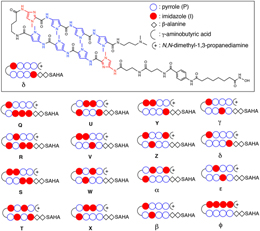Research Abstract
マウス胎児線維芽細胞において複数の全能性遺伝子を迅速に誘導する合成低分子
A synthetic small molecule for rapid induction of multiple pluripotency genes in mouse embryonic fibroblasts
2012年7月30日 Scientific Reports 2 : 544 doi: 10.1038/srep00544

細胞の再プログラム化には、エピジェネティックな情報によって正確に調節されているゲノム全体にわたる遺伝子発現の大きな変化が関与すると考えられている。これまでいくつかの低分子が、エピジェネティックな修飾を人為的に誘導することが示されている。最近我々は、DNAに特異的に結合するヘアピン状のピロールイミダゾールポリアミド(PIP)を、SAHAのようなクロマチンを修飾するヒストン脱アセチル化酵素阻害剤と結合させると、マウス胎児線維芽細胞でいくつかの全能性遺伝子をエピジェネティックな変化によって活性化することを明らかにした。SAHA-PIPの効果を改善する過程で、我々は、Oct-3/4およびNanogの内因性発現を著しく誘導するδと呼ぶ新規化合物を同定した。全ゲノム遺伝子解析の結果、δはわずか24時間nM濃度で処理するだけで、Rex1およびCdh1を含む複数の全能性に関連した遺伝子群を10倍以上誘導することを示した。δで処理したMEFはまた、複雑な遺伝子転写ネットワークを「スイッチON」にすることによって、細胞の再プログラム化における上皮移行の律速段階を速やかに乗り越えることが示された。
Ganesh N. Pandian1, 仲野 祐輔2, 佐藤 慎祐1, 森永 浩伸2, 板東 俊和2, 永瀬 浩喜3,4 & 杉山 弘1,2
- 京都大学物質-細胞統合システム拠点(WPI-iCeMS)
- 京都大学大学院 理学研究科 化学専攻
- 日本大学医学部 癌遺伝学分野
- 千葉県がんセンター研究所
Cellular reprogramming involves profound alterations in genome-wide gene expression that is precisely controlled by a hypothetical epigenetic code. Small molecules have been shown to artificially induce epigenetic modifications in a sequence independent manner. Recently, we showed that specific DNA binding hairpin pyrrole-imidazole polyamides (PIPs) could be conjugated with chromatin modifying histone deacetylase inhibitors like SAHA to epigenetically activate certain pluripotent genes in mouse fibroblasts. In our steadfast progress to improve the efficiency of SAHA-PIPs, we identified a novel compound termed, δ that could dramatically induce the endogenous expression of Oct-3/4 and Nanog. Genome-wide gene analysis suggests that in just 24 h and at nM concentration, δ induced multiple pluripotency-associated genes including Rex1 and Cdh1 by more than ten-fold. δ treated MEFs also rapidly overcame the rate-limiting step of epithelial transition in cellular reprogramming by switching “
 ” the complex transcriptional gene network.
” the complex transcriptional gene network.
 ” the complex transcriptional gene network.
” the complex transcriptional gene network. 
